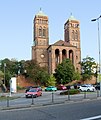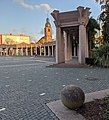
Pirmasens
Pirmasens (German pronunciation: [ˈpɪʁmazɛns] ⓘ; Palatine German: Bärmesens (also Bermesens or Bärmasens)) is an independent town in Rhineland-Palatinate, Germany, near the border with France. It was famous for the manufacture of shoes. The surrounding rural district was called Landkreis Pirmasens from 1818 until 1997, when it was renamed to Südwestpfalz.
Pirmasens
61.37 km2 (23.70 sq mi)
380 m (1,250 ft)
40,682
660/km2 (1,700/sq mi)
06331
PS
History[edit]
Early years[edit]
The first mention of "Pirminiseusna", a colony of Hornbach Abbey, dates from 860. The name derives from St. Pirminius, the founder of the monastery. During the period it was under rule of the Bishopric of Metz.[3][4] It was passed to Diocese of Speyer in last the quarter of the 11th century, then was captured by County of Saarbrücken in 1100.
In 1182, the County of Saarbrücken was divided by Simon II and Henry I, who were sons of Simon I. Pirmasens was given to the latter and Henry I's dominion was named as County of Zweibrücken.[5] He built Lemberg Castle for protecting his dominion in 1198. During the period Pirmasens was formal jurisdiction in Bishop of Metz. But, parish administration of Pirmasens was passed to monastery of Hornbach after confirmation of John, Bishop of Metz in 1225.
In 1297, County of Zweibrücken was divided and Pirmasens was passed to County of Zweibrücken-Bitsch, Eberhard I's dominion. He traded some localities with Duke Frederick III of Lorraine and took lordship of Bitsch at same year.
In 1525, during German Peasants' War, Pirmasens was looted by peasants of Bitsch.
In 1560, Ludowika Margaretha of Zweibrücken-Bitsch, was daughter of Count James of Zweibrücken-Bitsch (1510–1570), was the last male member of the House of Zweibrücken, was married of Philip V, Count of Hanau-Lichtenberg. In 1570, Count James of Zweibrücken-Bitsch died without male heir and Countess Ludowika Margaretha inherited the County of Bitsch, the Lordship of Ochsenstein and half the Lordship of Lichtenberg (his father already held the other half). James's older brother, Simon V Wecker, had already died in 1540, also without a male heir. A dispute about the inheritance erupted between the husbands of Ludowika Margaretha and her cousin Amalie, Philip V of Hanau-Lichtenberg and Philip I of Leiningen-Westerburg,[6] respectively. Formally, the County of Bitsch and district of Lemberg were fiefs of the Duchy of Lorraine and such fiefs could only be inherited in the male line.
Philip V was initially successful in the dispute with Philip I about Zweibrücken-Bitsch. However, he introduced the Lutheran confession in his newly gained territories in 1572. This upset his powerful Catholic neighbour and liege lord, Duke Charles III of Lorraine. The Duke terminated the fief and in July 1572 Lorraine troops occupied the county. Since Philip V's army was no match for Lorraine, he took his case to the Imperial Chamber Court in Speyer. During the trial, Lorraine argued that, firstly, a significant part of the territory of Zweibrücken-Bitsch had been obtained in an exchange with Lorraine in 1302 and, secondly, the Counts of Leiningen had sold their hereditary claims to Lorraine in 1573. In 1604, Hanau-Lichtenberg and Lorraine decided to settle out of court. In a treaty signed in 1606, it was agreed that Bitsch would revert to Lorraine and Hanau-Lichtenberg would retain Lemberg. This was reasonable, as it corresponded approximately to the religious realities of the territories. Since then, Pirmasens was part of the Amt Lemberg in the County of Hanau-Lichtenberg.
Before the Thirty Years War, Pirmasens had 59 families and about 235 inhabitants resident, whereas in Lemberg were counted 54 families (about 215 people). When counting is assumed that at that time there was a family of four to five people. In 1622, Pirmasens and Lemberg were ravaged by Spaniards and Croatian horsemen of the Imperial troops. The imperial army set fire to the village. Even the church was destroyed in a fire, after the withdrawal of the troops, Pirmasenser began to rebuild it.[7] It was again ravaged by imperial troops under Matthias Gallas. They also looted Lemberg Castle, which was burned in 1636. Then the headquarters of the Lutheran parish of Lemberg was moved to Pirmasens.[8] But, it was heavily damaged in it. In 1657, only 9 families (about 40 people) were lived in it. However, the population slowly increased by the immigration of Reformed Swiss, Catholic Tyrolean as well as Franconian and Württembergian families, so that in 1661 21 families (about 87 people) were counted in Pirmasens. However, during the Franco-Dutch War in 1677, the city was burned down again, this time by French troops. During the Nine Years' War, it was sacked by French troops under General de Ezéchiel Mélac, who devastated the Palatinate in 1689. In 1691, only 16 people lived in the village of Pirmasens. At the same time, the part of Lemberg Castle that was still habitable after the Thirty Years' War, was completely destroyed. Thus, the administrative centre of Amt Lemberg was moved to Pirmasens in 1697. This made Pirmasens the most important locality of the region.
In 1736, Johann Reinhard III, the last count of Hanau-Lichtenberg, died without male heir and the duchy passed to his grandson, Landgrave Ludwig IX of Hesse-Darmstadt, the son of Countess Charlotte of Hanau-Lichtenberg, sole heir of County of Hanau Lichtenberg, and Ludwig VIII, Landgrave of Hesse-Darmstadt.
Landgrave Ludwig IX took residence in his grandfathers hunting lodge in Pirmasens and established a garrison. In 1763, Pirmasens was granted city rights by Ludwig IX who stayed in his small residence even after taking office in Hesse-Darmstadt due to his father's death in 1768. The garrison was continuously expanded, a town hall, two churches and a large exercise hall were erected. Residence and garrison abruptly ended with the landgrave's death in 1790.
In 1793, it was the location of the Battle of Pirmasens between Prussia and the French Corps of the Vosges. The French lost the battle, but their opponents' divisions nevertheless enabled them to return and occupy Pirmasens by the end of the year: between 1798 and 1814, the town was included in the French département of Mont-Tonnerre ("Donnersberg-Département" in German). After the French defeat, it was made part of Bavaria together with the Rhenish Palatinate.
Evolution of population (since 1875):
Town council as at August 2014:
Military[edit]
Husterhoeh Kaserne was a former (1945–1994) US military facility in Pirmasens, and is now a mostly closed Bundeswehr facility, which still hosts U.S. Army Medical Materiel Center – Europe. It was a constituent member of the Kaiserslautern Military Community.









